|
Performance Q & A
In pursuit of a recent goal or title, what was an obstacle that you overcame?
Describe the process.
Noreen Bennett
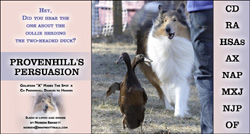 During the Agility course, there is a table on which the dogs must "pause."
In the middle of running the course, the dog is required to jump on the
table and either lay down or sit (pre-determined by the judge). It is to
demonstrate control during the course. During the last year, Suede had
gotten VERY slow to sit or lay down on the table, keep in mind that I cannot
touch him during the course. At one show, it was 22 seconds! So there were
a few shows that we would have qualified but were over time because of his
table "attitude." For dinner, I would give him a down command, which he
would do but I couldn't get him to increase the speed of laying down as much
as I would have liked; And yet, he was laying down. So, do I reward him? One night, I went to feed him and said, "Down," and he sat, and then laid down—sigh. I didn't give him his supper; I turned around and had Maestro perform
and fed him first. Then I turned back to Suede and said, "Down," and he hit the
ground quickly! We are still working on it but that was definitely a
turning point. There are times that both Maestro and Peyton will get fed
before Suede, if he's not responding. The bottom line is that obviously he can
lay down quicker when it's worth it. The result is that he's making the
choice to lay down quickly, which has carried over into the ring as compared
to me trying to "convince" hiim to lay down quickly. During the Agility course, there is a table on which the dogs must "pause."
In the middle of running the course, the dog is required to jump on the
table and either lay down or sit (pre-determined by the judge). It is to
demonstrate control during the course. During the last year, Suede had
gotten VERY slow to sit or lay down on the table, keep in mind that I cannot
touch him during the course. At one show, it was 22 seconds! So there were
a few shows that we would have qualified but were over time because of his
table "attitude." For dinner, I would give him a down command, which he
would do but I couldn't get him to increase the speed of laying down as much
as I would have liked; And yet, he was laying down. So, do I reward him? One night, I went to feed him and said, "Down," and he sat, and then laid down—sigh. I didn't give him his supper; I turned around and had Maestro perform
and fed him first. Then I turned back to Suede and said, "Down," and he hit the
ground quickly! We are still working on it but that was definitely a
turning point. There are times that both Maestro and Peyton will get fed
before Suede, if he's not responding. The bottom line is that obviously he can
lay down quicker when it's worth it. The result is that he's making the
choice to lay down quickly, which has carried over into the ring as compared
to me trying to "convince" hiim to lay down quickly.
Cindy Dorsten
(Who was recently in a serious car accident and is now recovering with the help of her collies)
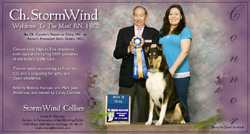 Just had a wonderful experience with Connor that I just have to share! I went out to my front porch to sit and enjoy the breeze. I checked for my cell phone, and had left it in the house somewhere. Rats! Connor was right by my side as he has been since the accident. I asked Connor to "Go find Momma's baby phone, go find baby phone." Connor took off inside the house, and I could tell from the shadow that he was looking. He peeked around the corner of the living room as if to say, "Say that, again?" I told him, "Find baby cell phone," and he took off to search. Within a minute he came briskly trotting back with the cell (wrapped in it's leather cover) in his mouth! I was SO pleased and proud of my boy! I praised him to High Heaven, thanked him profusely, hugged him, and gave him a peanut butter Oreo I happened to have. He has turned into my service dog as he will bring me pillows, dropped pens or papers, towels or washclothes; he'll help me get up on my walker if I'm on the floor, bracing and steadying me as I use his shoulders, and will bring dirty laundry to the washing machine! What more can I say. I am so proud and happy to have such a wonderful, intelligent and intuitive Collie boy! Just had a wonderful experience with Connor that I just have to share! I went out to my front porch to sit and enjoy the breeze. I checked for my cell phone, and had left it in the house somewhere. Rats! Connor was right by my side as he has been since the accident. I asked Connor to "Go find Momma's baby phone, go find baby phone." Connor took off inside the house, and I could tell from the shadow that he was looking. He peeked around the corner of the living room as if to say, "Say that, again?" I told him, "Find baby cell phone," and he took off to search. Within a minute he came briskly trotting back with the cell (wrapped in it's leather cover) in his mouth! I was SO pleased and proud of my boy! I praised him to High Heaven, thanked him profusely, hugged him, and gave him a peanut butter Oreo I happened to have. He has turned into my service dog as he will bring me pillows, dropped pens or papers, towels or washclothes; he'll help me get up on my walker if I'm on the floor, bracing and steadying me as I use his shoulders, and will bring dirty laundry to the washing machine! What more can I say. I am so proud and happy to have such a wonderful, intelligent and intuitive Collie boy!
Joan Scialdone
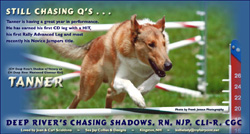 As far as overcoming obstacles goes, we’re actually working on one now. Tanner fell off the dogwalk last winter at class—not once, but twice. He had fallen off last fall but had worked through that and was still able to handle standard runs and earn his CPE Level 1 Standard title in October. After two more falls off the dogwalk, he now wants NO part of the obstacle. This problem has also transferred to the see saw; he won’t do that one either. As far as overcoming obstacles goes, we’re actually working on one now. Tanner fell off the dogwalk last winter at class—not once, but twice. He had fallen off last fall but had worked through that and was still able to handle standard runs and earn his CPE Level 1 Standard title in October. After two more falls off the dogwalk, he now wants NO part of the obstacle. This problem has also transferred to the see saw; he won’t do that one either.
My instructor and I have gone back to the beginning and are “back chaining” Tanner’s training to try and get him over the fear by having him put a paw at a time on each obstacle, clicking and rewarding him for doing that and eventually getting all four feet on so he’s standing on the Up plank; we want to make it a game so it’s fun and enjoyable and rebuild his trust and confidence.
This dogwalk is a small beginner one—half the height of a competition walk. It is a long process because we want him doing the obstacles willingly, not being forced into it. This is where the training plank and ladder will also come into play, so he will learn where all four of his feet are. This will take a long time; but I hope through patience and perseverance, we will get there.
Babbi Dilbeck, DVM
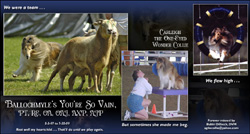 Dogwalk issues . . . Cole fell off of the dogwalk in training twice which resulted in avoiding the obstacle in Agility trials. When we finally worked through getting him back on the dogwalk at trials, he was so excited that he had done the obstacle that he jumped over the yellow contact zone at the end, resulting in MANY disqualifying runs (18 month's worth) in AKC standard Agility Excellent A classes. Dogwalk issues . . . Cole fell off of the dogwalk in training twice which resulted in avoiding the obstacle in Agility trials. When we finally worked through getting him back on the dogwalk at trials, he was so excited that he had done the obstacle that he jumped over the yellow contact zone at the end, resulting in MANY disqualifying runs (18 month's worth) in AKC standard Agility Excellent A classes.
The process: Driving home from Herding training one Sunday, I was once again going over methods I had tried and was considering trying to fix this dogwalk issue. I had just been working on a good stop and was getting really nice responses to "stand there" when Cole worked sheep. Then it hit me. I knew that Cole had no idea that he was supposed to touch in the yellow contact zone. I also knew that the numerous methods that I had tried so far were not conveying the message clearly to him. I also knew that if I could communicate the behavior I wanted in a fashion that he understood, Cole would do the dogwalk correctly. I do not believe that dogs "blow us off," but rather that undesired behaviors or incorrect performances are a matter of communication; either we're not getting the message to them or they aren't understanding what we want. These are training and communication problems, not the dog thumbing his or her nose at us.
I went straight to the Agility field on my way home, put Cole on the dogwalk, gave him the commands, "Easy," and "Stand There!" and got a PERFECT dogwalk performance the very first time. Since that day, we've had other issues (mostly handler error!) but—knock wood—his dogwalk performances have been perfect.
Sometimes you have to think outside the box and one set of training skills will cross over nicely to another discipline. It worked out great for this issue and it reminded me that there is more than one way to fix a problem and that not every solution works with every dog. Agilty can be so humbling sometimes.
Alicia Moore
Teaching my conformation dogs that they are ALLOWED to sit or lay down on a table can be a challenge. It took a bit of work, but I finally got a sit from them the last trial after practicing for about a month. Basically, it was the same as any other training; show the dog what you want, in this case I had to put them in the position (even though they sit and down off the table on command), reward them for any thing resembling the correct action, then gradually get them to do it on command. I also put a non-slip mat on the table to give them more stable footing.
Carol Lariviere
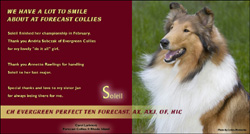 The biggest obstacle I faced in Agility happened last year. My dog, Soleil, has always loved Agility and runs the course expressing her enthusiasm by barking at me most of the way around. She took a pretty nasty tumble off of the dogwalk in the spring. She seemed fine afterwards but I took her to a vet who also does chiropractic work. Soleil needed an adjustment but was given the okay to trial the following weekend. She earned her AX on that Saturday placing second in a class of 18. But, everything changed for me on Sunday. My happy and enthusiastic dog was gone. She did parts of the standard course with some enthusiasm but we never finished the course, withdrawing about three-quarters of the way through when it was obvious she wasn't enjoying herself. Thinking it was a contact issue, we prepared to run JWW in the afternoon. Usually Soleil is so excited that she barks at any large dog running the course—not this particular afternoon. She shut down entirely and we never got over the first jump. The biggest obstacle I faced in Agility happened last year. My dog, Soleil, has always loved Agility and runs the course expressing her enthusiasm by barking at me most of the way around. She took a pretty nasty tumble off of the dogwalk in the spring. She seemed fine afterwards but I took her to a vet who also does chiropractic work. Soleil needed an adjustment but was given the okay to trial the following weekend. She earned her AX on that Saturday placing second in a class of 18. But, everything changed for me on Sunday. My happy and enthusiastic dog was gone. She did parts of the standard course with some enthusiasm but we never finished the course, withdrawing about three-quarters of the way through when it was obvious she wasn't enjoying herself. Thinking it was a contact issue, we prepared to run JWW in the afternoon. Usually Soleil is so excited that she barks at any large dog running the course—not this particular afternoon. She shut down entirely and we never got over the first jump.
My happy Agility dog was broken! I withdrew her from the upcoming trials but decided to take her to a couple of nearby trials and try to make the experience a happy one for her. She was very content to have treats and just sit by the ring silently watching the other dogs run. This was not my normal Soleil! I had a couple of other chiropractic appointments scheduled and I asked the vet to draw blood for a Lyme titer.
Well, lo and behold!! The Lyme titer was low but she had a moderate titer for Anaplasmosis. We began doxycycline treatment that day and I noticed her enthusiasm beginning to return at home within three days of starting treatment. It took a couple of trials for my happy Agility dog to return, but within about six weeks, she was back to normal. It was a heartbreaking three to four weeks before we determined the source of the problem.
My lesson for everyone is first and foremost, appreciate your dog everytime he or she plays the game with you. Qualifying runs are secondary to the partnership that is developed between you and your dog. Secondly, don't give up if you have a problem. It would have been easy to accept that the fall off of the dogwalk destroyed Soleil's confidence and she'd never run again. But in my heart, I knew Soleil loved Agility and it would take more than a fall to destroy that love.
Nancy Hehre
Flashback vs. the Dumbbell
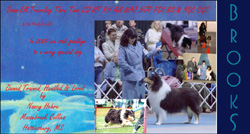 Flashback (a.k.a. Palary Time to Remember, CD, RAE) picked up her initial dumbbell training pretty fast. She learned to hold it, carry it, and bring it back on a recall. She would jump with it, return to front and deliver it to hand. She would take it readily from my hand in any position. The next step was taking my hand away. When the responsibility to pick it up became all hers she refused. She actively avoided the dumbbell refusing to even look at it. Force corrections don't work with Flash because she is too stubborn to care. She is very food motivated but that made no difference here. On the plus side she doesn't shut down or quit completely. She will try to figure out an easier way or offer a different behavior. Flashback (a.k.a. Palary Time to Remember, CD, RAE) picked up her initial dumbbell training pretty fast. She learned to hold it, carry it, and bring it back on a recall. She would jump with it, return to front and deliver it to hand. She would take it readily from my hand in any position. The next step was taking my hand away. When the responsibility to pick it up became all hers she refused. She actively avoided the dumbbell refusing to even look at it. Force corrections don't work with Flash because she is too stubborn to care. She is very food motivated but that made no difference here. On the plus side she doesn't shut down or quit completely. She will try to figure out an easier way or offer a different behavior.
So I backed up. Since “Fetch it” now meant take the dumbbell while my hand is on it, I changed the command from "fetch it" to "Adripe" (Latin for "seize with the teeth"). I started back at step one and progressed quickly back to our roadblock. Things got complicated as I re-located halfway across the country. Nevertheless, I continued to plug away at the retrieve issue with little progress, until I met my current trainer. At this point Flash would take a dumbbell from a chair at nose level, but I still had been unable to get my hand out of the picture. I was no longer holding the dumbbell but my hand was still on it.
Kathy evaluated the situation and believed it to be a confidence issue. Flashback always has to be right and if she isn’t sure she really understands then she simply refuses. Kathy suggested putting a cardboard box on the floor covered with a piece of ring matting and the dumbbell on the box. The box was suggested because it could be cut down slowly reducing the height very gradually. I started a couple feet from the box/dumbbell so Flash had a clear view, gave one command and took her to the dumbbell. I used my right foot to brace the box. I could point with my right hand but nothing more. Then I waited her out. I used a hold command when she put her mouth on the dumbbell then—jackpot—and end of session. Using this method, which took my hands out of the picture, while getting the dumbbell closer to the ground, I was able to reduce the height of the box fairly quickly and increase the number of pickups required as well. I now have a goal of five good pickups per session and the dumbbell is on the ground on a piece of ring matting.
One way I increased motivation and distance was to use her love of jumping. She is much more motivated to pick up the dumbbell if the jump is part of the reward. I now alternate retrieving on the flat with retrieving over the jump. I believe the jump gives her something to think about besides the dumbbell, less worry about being right equals quicker pickup. While we still have a ways to go to be ready for Open, we have gotten past the major obstacle in her retrieve training.
Angela Evers
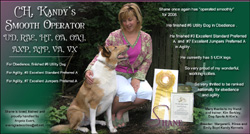 I do not believe in "obstacles" since to me an obstacle is a roadblock and
once you believe you have a roadblock it is something that cannot be
avoided. If you look for traps or think something will be a problem, more
than likely it will become a problem. I do not think in terms of "cannot"
since when you even begin to think you cannot, you will not. I believe I
can, but more importantly, I believe my dog can and trust that he or she
will. Whether it is in Obedience, Agility, Herding or Tracking, I do not
look for the obstacle. I believe in my dog. I do not believe in "obstacles" since to me an obstacle is a roadblock and
once you believe you have a roadblock it is something that cannot be
avoided. If you look for traps or think something will be a problem, more
than likely it will become a problem. I do not think in terms of "cannot"
since when you even begin to think you cannot, you will not. I believe I
can, but more importantly, I believe my dog can and trust that he or she
will. Whether it is in Obedience, Agility, Herding or Tracking, I do not
look for the obstacle. I believe in my dog.
Michele and Brian Brane
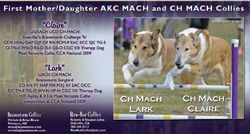 Our smooth collie, Claire, (UGRACH UCD CH MACH Row-Bar's Branestorm Challenge 'Er CDX HSAs NAP NJP OF RN ROM-P EAC ECC EJC TG-E O-TN-E WV-O RS-O JS-E GS-O CGC VX Therapy Dog), trained by Brian, finished her MACH in April. Our smooth collie, Claire, (UGRACH UCD CH MACH Row-Bar's Branestorm Challenge 'Er CDX HSAs NAP NJP OF RN ROM-P EAC ECC EJC TG-E O-TN-E WV-O RS-O JS-E GS-O CGC VX Therapy Dog), trained by Brian, finished her MACH in April.
The biggest obstacle in getting Claire's MACH was her lack of speed. She can
be very fast when she wants to be, but, tends to be very deliberate when
running an Agility course; I attribute this to asking for too much
precision in her early training rather than keeping her moving and letting
her have fun. I took her to seminars and asked trainers and fellow
competitors how to speed her up.
There was no magic bullet, but the things that seemed to help were:
- Doing blind crosses (sorry Ronda) to trigger her prey drive,
- Keeping moving on the course, which often means I'm running the outside of
pinwheels and tunnels,
- Giving her cheese (her favorite treat) after EVERY weave performance in
training so she is less likely to walk through the weaves at a trial,
- Racing her to the end of contacts and giving her a treat,
- Sprinting with her right before an agility run,
- Teasing her with cheese while we wait for our turn to run (being careful
to avoid getting bitten when she's lunging for the cheese),
- Promising her lots of cheese after the run if she runs fast,
- Always giving her cheese after the run regardless of how fast she ran,
- Entering every trial we could get to,
- And most importantly, praying earnestly that she'd eventually get her MACH.
After five years in Excellent B, Claire finally reached 750 points and got her
MACH. She's now running preferred and enjoys the lower jump height. We hope
to be in Excellent Preferred soon, so Claire can start working on her PAX.
|